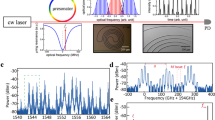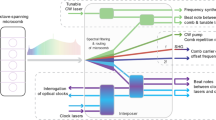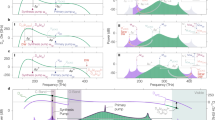Abstract
Microcombs—optical frequency combs generated by nonlinear integrated microcavity resonators—have the potential to offer the full capability of their benchtop counterparts, but in an integrated footprint. They have enabled breakthroughs in spectroscopy, microwave photonics, frequency synthesis, optical ranging, quantum sources, metrology, optical neuromorphic processing and more. One of their most successful applications is in optical-fibre communications, where they have formed the basis for massively parallel ultrahigh-capacity multiplexed data transmission. Innovative approaches have been used in recent years to phase-lock or mode-lock different types of microcombs, from dissipative Kerr solitons to dark solitons, soliton crystals and others, and this has enabled their use as sources for advanced coherent modulation-format optical communications systems, which have achieved ultrahigh data capacity bit rates breaking the petabit-per-second barrier. Here we review this new and exciting field, chronicling the progress and highlighting the challenges and opportunities.
This is a preview of subscription content, access via your institution
Access options
Access Nature and 54 other Nature Portfolio journals
Get Nature+, our best-value online-access subscription
$32.99 / 30 days
cancel any time
Subscribe to this journal
Receive 12 print issues and online access
$259.00 per year
only $21.58 per issue
Buy this article
- Purchase on SpringerLink
- Instant access to full article PDF
Prices may be subject to local taxes which are calculated during checkout





Similar content being viewed by others
References
Winzer, P. J. & Neilson, D. T. From scaling disparities to integrated parallelism: a decathlon for a decade. J. Lightwave Technol. 35, 1099–1115 (2017).
Winzer, P. J., Neilson, D. T. & Chraplyvy, A. R. Fibre-optic transmission and networking: the previous 20 and the next 20 years. Opt. Express 26, 24190–24239 (2018).
Hänsch, T. W. Nobel lecture: passion for precision. Rev. Mod. Phys. 78, 1297–1309 (2006).
Hall, J. L. Nobel lecture: Defining and measuring optical frequencies. Rev. Mod. Phys. 78, 1279–1295 (2006).
Diddams, S. A., Vahala, K. & Udem, T. Optical frequency combs: coherently uniting the electromagnetic spectrum. Science 369, eaay3676 (2020).
Puttnam, B. J. et al. 2.15 Pb/s transmission using a 22 core homogeneous single-mode multi-core fibre and wideband optical comb. In Proc. 2015 European Conference on Optical Communication (ECOC) 1–3 https://doi.org/10.1109/ECOC.2015.7341685 (IEEE, 2015).
Rademacher, G. et al. Highly spectral efficient C + L-band transmission over a 38-core-3-mode fibre. J. Lightwave Technol. 39, 1048–1055 (2021).
Del’Haye, P. et al. Optical frequency comb generation from a monolithic microresonator. Nature 450, 1214–1217 (2007).
Pasquazi, A. et al. Micro-combs: a novel generation of optical sources. Phys. Rep. 729, 1–81 (2018).
Kippenberg, T. J., Gaeta, A. L., Lipson, M. & Gorodetsky, M. L. Dissipative Kerr solitons in optical microresonators. Science 361, eaan8083 (2018).
Gaeta, A. L., Lipson, M. & Kippenberg, T. J. Photonic-chip-based frequency combs. Nat. Photon. 13, 158–169 (2019).
Sun, Y. et al. Applications of optical micro-combs. Adv. Opt. Photon. 15, 86–175 (2023).
Marin-Palomo, P. et al. Microresonator-based solitons for massively parallel coherent optical communications. Nature 546, 274–279 (2017).
Corcoran, B. et al. Ultra-dense optical data transmission over standard fibre with a single chip source. Nat. Commun. 11, 2568 (2020).
Pfeifle, J. et al. Coherent terabit communications with microresonator Kerr frequency combs. Nat. Photon. 8, 375–380 (2014).
Fulop, A. et al. High-order coherent communications using mode-locked dark-pulse Kerr combs from microresonators. Nat. Commun. 9, 1598 (2018).
Fujii, S. et al. Dissipative Kerr soliton microcombs for FEC-free optical communications over 100 channels. Opt. Express 30, 1351–1364 (2022).
Jørgensen, A. A. et al. Petabit-per-second data transmission using a chip-scale microcomb ring resonator source. Nat. Photon. 16, 798–802 (2022).
Razzari, L. et al. CMOS-compatible integrated optical hyper-parametric oscillator. Nat. Photon. 4, 41–45 (2010).
Levy, J. S. et al. CMOS-compatible multiple-wavelength oscillator for on-chip optical interconnects. Nat. Photon. 4, 37–40 (2010).
Moss, D. J., Morandotti, R., Gaeta, A. L. & Lipson, M. New CMOS-compatible platforms based on silicon nitride and Hydex for nonlinear optics. Nat. Photon. 7, 597–607 (2013).
Herr, T. et al. Temporal solitons in optical microresonators. Nat. Photon. 8, 145–152 (2014).
Cole, D. C., Lamb, E. S., Del’Haye, P., Diddams, S. A. & Papp, S. B. Soliton crystals in Kerr resonators. Nat. Photon. 11, 671–676 (2017).
Tan, M. et al. RF and microwave photonic temporal signal processing with Kerr micro-combs. Adv. Phys. X 6, 1838946 (2021).
Xue, X. et al. Mode-locked dark pulse Kerr combs in normal-dispersion microresonators. Nat. Photon. 9, 594–600 (2015).
Bao, H. et al. Laser cavity-soliton microcombs. Nat. Photon. 13, 384–389 (2019).
Lihachev, G. et al. Platicon microcomb generation using laser self-injection locking. Nat. Commun. 13, 1771 (2022).
Peccianti, M. et al. Demonstration of an ultrafast nonlinear microcavity modelocked laser. Nat. Commun. 3, 765 (2012).
Saha, K. et al. Modelocking and femtosecond pulse generation in chip-based frequency combs. Opt. Express 21, 1335–1343 (2013).
Ferdous, F. et al. Spectral line-by-line pulse shaping of on-chip microresonator frequency combs. Nat. Photon. 5, 770–776 (2011).
Guo, H. et al. Universal dynamics and deterministic switching of dissipative Kerr solitons in optical microresonators. Nat. Phys. 13, 94–102 (2017).
Wang, P.-H. et al. Observation of correlation between route to formation, coherence, noise and communication performance of Kerr combs. Opt. Express 20, 29284–29295 (2012).
Matsko, A. A. et al. Mode-locked Kerr frequency combs. Opt. Lett. 36, 2845–2847 (2011).
Coen, S., Randle, H. G., Sylvestre, T. & Erkintalo, M. Modeling of octave spanning Kerr frequency combs using a generalized mean-field Lugiato-Lefever model. Opt. Lett. 38, 37–39 (2013).
Lugiato, L. A. & Lefever, R. Spatial dissipative structures in passive optical systems. Phys. Rev. Lett. 58, 2209–2211 (1987).
Haelterman, M., Trillo, S. & Wabnitz, S. Dissipative modulation instability in a nonlinear dispersive ring cavity. Opt. Commun. 91, 401–407 (1992).
Wabnitz, S. Suppression of interactions in a phase-locked soliton optical memory. Opt. Lett. 18, 601–603 (1993).
Stern, B., Ji, X., Okawachi, Y., Gaeta, A. L. & Lipson, M. Battery-operated integrated frequency comb generator. Nature 562, 401–405 (2018).
Liu, J. et al. Monolithic piezoelectric control of soliton microcombs. Nature 583, 385–390 (2020).
Shen, B. et al. Integrated turnkey soliton microcombs. Nature 582, 365–369 (2020).
Chang, L., Liu, S. & Bowers, J. E. Integrated optical frequency comb technologies. Nat. Photon. 16, 95–108 (2022).
Rowley, M. et al. Self-emergence of robust solitons in a microcavity. Nature 608, 303–309 (2022).
Cutrona, A. et al. High parametric efficiency in laser cavity-soliton microcombs. Opt. Express 30, 39816–39825 (2022).
Helgason, Ó. B. et al. Surpassing the nonlinear conversion efficiency of soliton microcombs. Nat. Photon. 17, 992–999 (2023).
Boggio, J. M. C. et al. Efficient Kerr soliton comb generation in micro-resonator with interferometric back-coupling. Nat Commun. 13, 1292 (2022).
Li, Q. et al. Stably accessing octave-spanning microresonator frequency combs in the soliton regime. Optica 4, 193–203 (2017).
Liu, J. et al. Photonic microwave generation in the X- and K-band using integrated soliton microcombs. Nat. Photon. 14, 486–491 (2021).
Suh, M.-G. & Vahala, K. Gigahertz-repetition-rate soliton microcombs. Optica 5, 65–66 (2018).
Xiang, C. et al. Laser soliton microcombs heterogeneously integrated on silicon. Science 373, 99–103 (2021).
Xiang, C. et al. 3D integration enables ultralow-noise isolator-free lasers in silicon photonics. Nature 620, 78–85 (2023).
Boes, A. et al. Lithium niobate photonics: unlocking the electromagnetic spectrum. Science 379, eabj4396 (2023).
Luke, K., Dutt, A., Poitras, C. B. & Lipson, M. Overcoming Si3N4 film stress limitations for high quality factor ring resonators. Opt. Express 21, 22829–22833 (2013).
El Dirani, H. et al. Annealing-free Si3N4 frequency combs for monolithic integration with Si photonics. Appl. Phys. Lett 113, 081102 (2018).
Frigg, A. et al. Optical frequency comb generation with low temperature reactive sputtered silicon nitride waveguides. APL Photon. 5, 011302 (2019).
Rebolledo-Salgado, I. et al. Platicon dynamics in photonic molecules. Commun. Phys. 6, 303 (2023).
Helgason, Ó. B. et al. Dissipative solitons in photonic molecules. Nat. Photon. 15, 305–310 (2021).
Xue, X. et al. Normal-dispersion microcombs enabled by controllable mode interactions. Laser Photon. Rev. 9, L23–L28 (2015).
Kim, B. Y. et al. Turn-key, high-efficiency Kerr comb source. Opt. Lett. 44, 4475–4478 (2019).
Rebolledo-Salgado, I. et al. Photonic molecule microcombs at 50 GHz repetition rate. In Conference on Lasers and Electro-Optics, Technical Digest Series Paper SW4O.8 (Optica Publishing Group, 2022).
Wang, W. et al. Robust soliton crystals in a thermally controlled microresonator. Opt. Lett. 43, 2002–2005 (2018).
Nguyen, T. G. et al. Integrated frequency comb source based Hilbert transformer for wideband microwave photonic phase analysis. Opt. Express 23, 22087 (2015).
Wu, J. et al. RF photonics: an optical micro-combs’ perspective. IEEE J. Sel. Top. Quantum Electron. 24, 6101020 (2018).
Xu, X. et al. Photonic microwave true time delays for phased array antennas using a 49 GHz FSR integrated optical micro-comb source. OSA Photonics Research Journal, Special Issue on Integrated Nonlinear Photonics 6, B30–B36 (2018).
Xu, X. et al. 11 TOPs photonic convolutional accelerator for optical neural networks. Nature 589, 44–51 (2021).
Karpov, M. et al. Dynamics of soliton crystals in optical microresonators. Nat. Phys. 15, 1071–1077 (2019).
Murray, C. E. et al. Investigating the thermal robustness of soliton crystal microcombs. Opt. Express 31, 37749–37762 (2023).
Mazur, M. et al. High spectral efficiency coherent superchannel transmission with soliton microcombs. J. Lightwave Technol. 39, 4367–4373 (2021).
Nakazawa, M., Yamamoto, T. & Tamura, K. R. 1.28 Tbit/s–70 km OTDM transmission using third- and fourth-order simultaneous dispersion compensation with a phase modulator. Electron. Lett. 36, 2027–2029 (2000).
Weber, H. G. et al. Single channel 1.28 Tbit/s and 2.56 Tbit/s DQPSK transmission. In Proc. IET Conference, v6:3-v6:3 (IET, 2005); https://doi.org/10.1049/cp:20050848
Hu, H. et al. Single-source chip-based frequency comb enabling extreme parallel data transmission. Nat. Photon. 12, 469–473 (2018).
Hillerkuss, D. et al. 26 Tbit s−1 line-rate super-channel transmission utilizing all-optical fast Fourier transform processing. Nat. Photon. 5, 364–371 (2011).
Hillerkuss, D. et al. Single-laser 32.5 Tbit/s Nyquist WDM transmission. J. Opt. Commun. Netw. 4, 715–723 (2012).
Ataie, V. et al. Ultrahigh count coherent WDM channels transmission using optical parametric comb-based frequency synthesizer. J. Lightwave Technol. 33, 694–699 (2015).
Anandarajah, P. M. et al. Generation of coherent multicarrier signals by gain switching of discrete mode lasers. IEEE Photon. J. 3, 112–122 (2011).
Yu, M. et al. Integrated femtosecond pulse generator on thin-film lithium niobate. Nature 612, 252–258 (2022).
Verolet, T. et al. Mode locked laser phase noise reduction under optical feedback for coherent DWDM communication. J. Lightwave Technol. 38, 5708–5715 (2020).
Hermans, A., Van Gasse, K. & Kuyken, B. On-chip optical comb sources. APL Photon. 7, 100901 (2022).
Corcoran, B. & Prayoonyong, C. A perspective on optical microcomb distillation: a tool to break power barriers for tiny rainbows. APL Photon. 9, 010903 (2024).
Prayoonyong, C. & Corcoran, B. Quantifying the impact of frequency comb distillation on comb-based optical communications systems. J. Lightwave Technol. 41, 3034–3045 (2023).
Corcoran, B. et al. Ultra-high bandwidth network transmission field trial using a soliton-crystal micro-comb source. In Proc. European Conference on Optical Communications (ECOC) (IET, 2019); https://doi.org/10.1049/cp.2019.0882
Torres-Company, V., Schröder, J. & Andrekson, P. A. Laser frequency combs for coherent optical communications. J. Lightwave Technol. 37, 1663–1670 (2019).
Marin-Palomo, P. et al. Performance of chip-scale optical frequency comb generators in coherent WDM communications. Opt. Express 28, 12897–12910 (2020).
Lundberg, L. et al. Phase-coherent lightwave communications with frequency combs. Nat. Commun. 11, 201 (2020).
Mazur, M., Schroder, J., Karlsson, M. & Andrekson, P. A. Joint superchannel digital signal processing for effective inter-channel interference cancellation. J. Lightwave Technol. 38, 5676–5684 (2020).
Mazur, M. et al. Optical frequency comb modulator for multichannel systems. Proc. ECOC https://doi.org/10.1049/cp.2019.1029 (2019).
Drayss, D. et al. Optical Arbitrary Waveform Generation and Measurement (OAWG/OAWM) enabling 320 GBd 32QAM transmission. In Proc. CLEO 2023, Technical Digest Series Paper STh5C.8 (Optica Publishing Group, 2023); https://doi.org/10.1364/CLEO_SI.2023.STh5C.8
Drayss, D. et al. Non-sliced optical arbitrary waveform measurement (OAWM) using soliton microcombs. Optica 10, 888–896 (2023).
Mocker, H. W. & Collins, R. J. Mode competition and self-injection locking effects in a Q-switched ruby laser. Appl. Phys. Lett. 7, 270–273 (1965).
Liu, Y. et al. A photonic integrated circuit-based erbium-doped amplifier. Science 376, 1309–1313 (2022).
Moille, G. et al. Kerr-induced synchronization of a cavity soliton to an optical reference. Nature 624, 267–274 (2023).
Taheri, H., Matsko, A. B. & Maleki, L. Optical lattice trap for Kerr solitons. Eur. Phys. J. D 71, 153 (2017).
Wildi, T., Ulanov, A., Englebert, N., Voumard, T. & Herr, T. Sideband injection locking in microresonator frequency combs. APL Photon. 8, 120801 (2023).
Obrzud, E., Lecomte, S. & Herr, T. Temporal solitons in microresonators driven by optical pulses. Nat. Photon. 11, 600–607 (2017).
Li, J. et al. Efficiency of pulse pumped soliton microcombs. Optica 9, 231–239 (2022).
Rizzo, A. et al. Massively scalable Kerr comb-driven silicon photonic link. Nat. Photon. 17, 781–790 (2023).
Prayoonyong, C. et al. Frequency comb distillation for optical superchannel transmission. J. Lightwave Technol. 39, 7383–7392 (2021).
Jia, S. et al. 150 Gbit/s 1 km high-sensitivity FSO communication outfield demonstration based on a soliton microcomb. Opt. Express 30, 35300–35310 (2022).
Dochhan, A. et al. 13.16 Tb/s free-space optical transmission over 10.45 km for geostationary satellite feeder links. In Photonic Networks; 20th ITG-Symposium, 12–14 (2019).
Amazon’s Project Kuiper Completes Successful Tests of Optical Mesh Network in Low Earth Orbit. Amazon (14 December 2023); https://www.aboutamazon.com/news/innovation-at-amazon/amazon-project-kuiper-oisl-space-laser-december-2023-update
TeraByte InfraRed Delivery (NASA, 2017); https://www.nasa.gov/wp-content/uploads/2017/10/tbird_fact_sheet_v2.pdf
Murphy, K. Lasers Light the Way for Artemis II Moon Mission. ESC, LEMNOS, Artemis, Lasercommunication (3 June 2021); https://esc.gsfc.nasa.gov/news/Lasers_Light_the_Way_for_Artemis_II_Moon_Mission
Shu, H. et al. Microcomb-driven silicon photonic systems. Nature 605, 457–463 (2022).
Guo, Y. et al. Submarine optical fiber communication provides an unrealized deep-sea observation network. Sci. Rep. 13, 15412 (2023).
Acknowledgements
This work was supported by the Australian Research Council (ARC) Centre of Excellence in Optical Microcombs for Breakthrough Science (no. CE230100006), and the Danish National Research Foundation (DNRF) Centre of Excellence, SPOC (Silicon Photonics for Optical Communications, DNRF123).
Author information
Authors and Affiliations
Corresponding author
Ethics declarations
Competing interests
The authors declare no competing interests.
Peer review
Peer review information
Nature Photonics thanks Stefan Wabnitz, Anthony Rizzo and the other, anonymous, reviewer(s) for their contribution to the peer review of this work.
Additional information
Publisher’s note Springer Nature remains neutral with regard to jurisdictional claims in published maps and institutional affiliations.
Rights and permissions
Springer Nature or its licensor (e.g. a society or other partner) holds exclusive rights to this article under a publishing agreement with the author(s) or other rightsholder(s); author self-archiving of the accepted manuscript version of this article is solely governed by the terms of such publishing agreement and applicable law.
About this article
Cite this article
Corcoran, B., Mitchell, A., Morandotti, R. et al. Optical microcombs for ultrahigh-bandwidth communications. Nat. Photon. 19, 451–462 (2025). https://doi.org/10.1038/s41566-025-01662-9
Received:
Accepted:
Published:
Issue date:
DOI: https://doi.org/10.1038/s41566-025-01662-9



